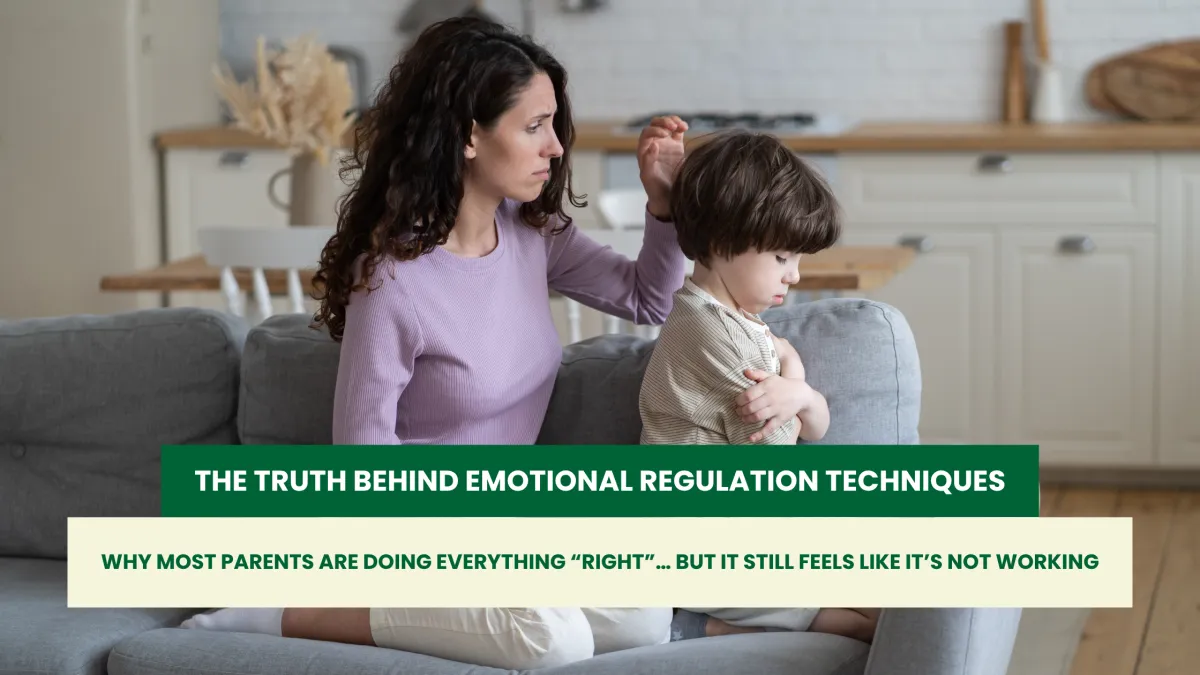
The Truth Behind Emotional Regulation Techniques
You’ve read the blogs. You’ve downloaded the emotion charts. You’ve tried deep breathing, “calm-down corners,” and maybe even yoga for kids.
But your child is still melting down at the dinner table. Or falling apart during transitions. Or getting overwhelmed by the smallest change in routine.
You’re not failing.
The strategies aren’t failing either.
The truth is: most emotional regulation techniques aren’t wrong—they’re just incomplete. Especially for neurodivergent kids.
As a child psychologist who specializes in autism, ADHD, and other neurodevelopmental conditions, I’ve seen countless well-meaning parents feel defeated by the gap between what’s supposed to work and what actually works for their child.
In this article, I want to unpack what emotional regulation really is, why it’s so hard for neurodivergent kids, and how to reframe your role as a parent—not as a behavior manager, but as a co-regulator, coach, and connector.
💬 What Is Emotional Regulation, Really?
At its core, emotional regulation is the ability to monitor, evaluate, and modify emotional reactions to meet goals or situational demands (Gross, 1998). It includes:
Awareness of what you're feeling
Understanding where that feeling comes from
Modulating that feeling in an adaptive way
But here’s the catch: those steps rely on brain systems that are still developing—especially in kids. For children with ADHD or autism, development in areas like impulse control, interoception (internal body awareness), and self-reflection may look quite different.
🧠 Co-Regulation vs. Self-Regulation: The Foundation Parents Miss
You can’t ask a child to calm down if their nervous system doesn’t feel safe. That’s where co-regulation comes in. It’s the process by which a trusted adult helps a child regulate—through presence, attunement, and emotional modeling.
“Self-regulation is born from repeated experiences of co-regulation.”
— Siegel & Bryson, The Whole-Brain Child
Before teaching breathing techniques or labeling emotions, we need to ask:
👉 Does my child feel emotionally safe enough to regulate?
👉 Am I regulating with them… or just trying to fix them?
❌ The Most Common Emotional Regulation Myths Parents Hear
1. “They just need to learn to calm down.”
Calming down is the end of the regulation process—not the beginning. A dysregulated child is in survival mode—logic and language are offline (Porges, 2011).
2. “They should know better by now.”
Development is not linear—especially for neurodivergent kids. A 10-year-old may have language and cognitive skills far beyond their emotional regulation capacity.
3. “They’re manipulating me.”
What looks like manipulation is often dysregulation. Kids don’t fake being overwhelmed. They fake being okay.
🧰 What Actually Helps: Evidence-Based Strategies That Work
Here are regulation techniques that actually support children—especially autistic or ADHD kids—when applied in developmentally appropriate ways:
✅ 1. Co-Regulation First
Use soft voice tone, body proximity, and predictable routines. Safety and connection are preconditions to regulation.
✅ 2. Externalizing the Emotion
Use visuals, metaphors, or tools like the Zones of Regulation to “get the feeling out of their body and onto the page.” This can reduce overwhelm.
Example: I once used color-coded LEGO bricks to represent emotions—red for anger, blue for sadness. We built 'emotion towers' before bed.
✅ 3. Teach Regulation Outside the Crisis
The best time to practice regulation skills is not during a meltdown—it’s during calm moments. That’s when you can model, role-play, and build scripts.
Use social stories
Roleplay “what if” situations
Create personalized “toolkits” (fidgets, visuals, scent bottles)
✅ 4. Honor Sensory Needs
Sensory overload is often misinterpreted as defiance. Build a sensory profile for your child and proactively accommodate their needs (Tomchek & Dunn, 2007).
Example: I had a client who always melted down in noisy cafeterias. Once the school added a quiet lunch table with headphones, everything changed.
✅ 5. Use Visual Schedules and Predictability
Transitions are one of the biggest stressors for neurodivergent children. Visual schedules give the brain something to “hold on to” during uncertainty.
Use icons, photos, or drawings
Always preview what’s next—even “fun” surprises can feel threatening
❤️ Emotional Regulation Is a Relationship, Not a Skill
The heart of emotional regulation is not technique—it’s connection.
Your calm becomes their calm. Your presence wires their brain for safety.
If you take nothing else from this article, take this:
Kids don’t learn emotional regulation from worksheets.
They learn it from you—your nervous system, your modeling, your love.
✋ What to Do When It’s Not Working
Sometimes, even with the best tools, things fall apart. That doesn’t mean your child is broken—or that you are.
It may mean:
You need more support (from a clinician, coach, or educator)
Your child is dealing with underlying stressors (trauma, sensory overwhelm, social struggles)
The strategies need to be reframed, adapted, or practiced with more co-regulation
🔁 Final Thoughts: Rewire Your Expectations, Not Just Their Reactions
Regulation is not about control. It’s about safety.
It’s about helping kids learn what to do with their big feelings—not how to suppress them.
So next time your child is losing it, ask yourself:
Are they safe?
Am I calm enough to be their co-regulator?
Am I expecting them to use tools they don’t yet have the brain wiring to use?
Because regulation isn’t a checklist—it’s a lifelong relationship. And you're not behind. You’re building something that matters.
📚 References (APA format)
Gross, J. J. (1998). The emerging field of emotion regulation: An integrative review. Review of General Psychology, 2(3), 271–299. https://doi.org/10.1037/1089-2680.2.3.271
Porges, S. W. (2011). The polyvagal theory: Neurophysiological foundations of emotions, attachment, communication, and self-regulation. W.W. Norton & Company.
Siegel, D. J., & Bryson, T. P. (2011). The whole-brain child: 12 revolutionary strategies to nurture your child’s developing mind. Random House.
Tomchek, S. D., & Dunn, W. (2007). Sensory processing in children with and without autism: A comparative study using the Short Sensory Profile. American Journal of Occupational Therapy, 61(2), 190–200. https://doi.org/10.5014/ajot.61.2.190
